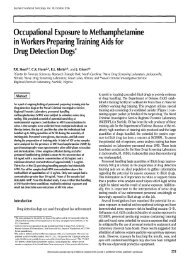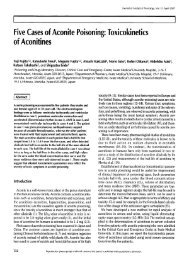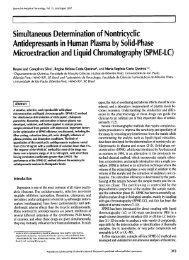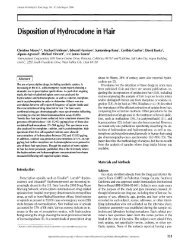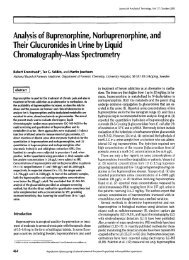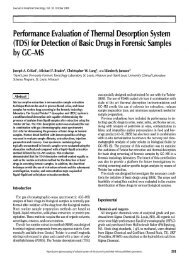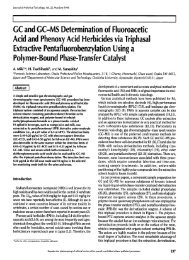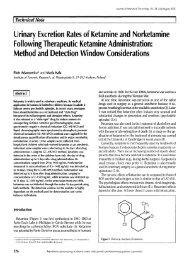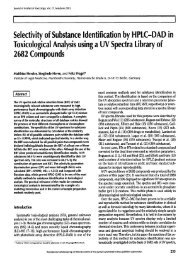Severe Intoxication with the Veterinary Tranquilizer Xylazine in ...
Severe Intoxication with the Veterinary Tranquilizer Xylazine in ...
Severe Intoxication with the Veterinary Tranquilizer Xylazine in ...
You also want an ePaper? Increase the reach of your titles
YUMPU automatically turns print PDFs into web optimized ePapers that Google loves.
Journal of Analytical Toxicology, Vol. 25, May/June 2001<br />
<strong>Severe</strong> <strong>Intoxication</strong> <strong>with</strong> <strong>the</strong> <strong>Veter<strong>in</strong>ary</strong> <strong>Tranquilizer</strong><br />
<strong>Xylaz<strong>in</strong>e</strong> <strong>in</strong> Humans<br />
U. Hoffmann 1,*, C.M. Meister 2, K. Golle 2, and M. Zschiesche 1<br />
1Departrnent of Pharmacology, Ernst-Moritz-Arndt University Greifswald, Friedrich-Loeffler-Str. 23 d, D-17489 Greifswald, Germany<br />
and 2Department of Anaes<strong>the</strong>siology, Central Hospital, Wollweber Str. 21, D- 17109 Demm<strong>in</strong>, Germany<br />
Abstract[<br />
<strong>Xylaz<strong>in</strong>e</strong> (Rompun | Proxylaz | is a veter<strong>in</strong>ary tranquiliz<strong>in</strong>g agent.<br />
A case of self-<strong>in</strong>jection of 1.5 g xylaz<strong>in</strong>e by a 27-year-old farmer is<br />
reported. He subsequently became comatose, hypotensive,<br />
bradycardic, and mildly glycemlc. An <strong>in</strong>tensive supportive <strong>the</strong>rapy<br />
<strong>in</strong>clud<strong>in</strong>g <strong>in</strong>tubation and ventilation was required. The patient<br />
made a full recovery over <strong>the</strong> next 30 h. The largest concentrations<br />
measured were 4.6 mg/L <strong>in</strong> plasma, 446 mg/L <strong>in</strong> gastric fluid, and<br />
194 mg/L <strong>in</strong> ur<strong>in</strong>e. The calculated plasma half-life was 4.9 h.<br />
K<strong>in</strong>etic data correlated <strong>with</strong> cl<strong>in</strong>ical symptoms. Qualitative and<br />
quantitative analyses of xylaz<strong>in</strong>e were done by th<strong>in</strong>-layer<br />
chromatography, gas chromatography-mass spectrometry, and<br />
high-performance liquid chromatography. These methods allow <strong>the</strong><br />
detection "of small amounts substance <strong>in</strong> stomach, plasma, and<br />
ur<strong>in</strong>e. Liquid-liquid extraction was used for <strong>the</strong> isolation of drug.<br />
The sensitvity is high, and <strong>with</strong> <strong>the</strong>se methods, a rapid analysis is<br />
possible. <strong>Xylaz<strong>in</strong>e</strong> <strong>in</strong>toxications <strong>in</strong> humans are rare. We describe<br />
<strong>the</strong> management of acute poison<strong>in</strong>g and present a review of<br />
xyl;~z<strong>in</strong>e toxicity <strong>in</strong> humans.<br />
Introduction<br />
<strong>Xylaz<strong>in</strong>e</strong> hydrochloride is <strong>the</strong> generic name for [2-(2.6-<br />
dimethylphenylam<strong>in</strong>o)-4-H-5.6-dihydro- 1.3]thiaz<strong>in</strong>e hydro-<br />
chloride, which is extensively used <strong>in</strong> veter<strong>in</strong>ary practice ei<strong>the</strong>r<br />
alone as a sedative or <strong>in</strong> comb<strong>in</strong>ation <strong>with</strong> o<strong>the</strong>r drugs for seda-<br />
tion, analgesia, or general anes<strong>the</strong>sia. It is marketed under <strong>the</strong><br />
trade names Rompun (Bayer) and Proxylaz (Prodivet/Atarost)<br />
and is available <strong>in</strong> 2, 5, and 10% solutions or as dry product con-<br />
ta<strong>in</strong><strong>in</strong>g 500 mg per vial. Chemical structure and pharmacolog-<br />
ical properties are similar to <strong>the</strong> phenothiaz<strong>in</strong>es and <strong>the</strong><br />
antisympathonic agent clonid<strong>in</strong> (Figure 1). <strong>Xylaz<strong>in</strong>e</strong> acts by<br />
stimulat~ofi of r <strong>in</strong> <strong>the</strong> central and peripheral nervous<br />
system. CNg-mediated actions <strong>in</strong>clude strong sedation and res-<br />
piratory depression. Plasma levels of norep<strong>in</strong>ephr<strong>in</strong>e, ep<strong>in</strong>-<br />
ephr<strong>in</strong>e, <strong>in</strong>sul<strong>in</strong>, and non-esterified fatty acids are decreased, and<br />
9 Author tO whom correspondence should be addressed: Dr. Ulrich Hoffmann, Depanrnent of<br />
Pharmacology, Ernst-Moritz-Amdt Universily, F.-L~effler-Str. 23 d, D- 17487 Greifswald, Germany.<br />
E-mail: jaki@rnaihuni-gceil'swald.de.<br />
glucose is <strong>in</strong>creased. The <strong>the</strong>rapeutic <strong>in</strong>dex is relatively small (1),<br />
and two- to threefold overdose can lead to collapse or death of <strong>the</strong><br />
animal due to circulatory and respiratory depression (2).<br />
<strong>Xylaz<strong>in</strong>e</strong> has also been <strong>in</strong>vestigated <strong>in</strong> humans, but was fre-<br />
quently associated <strong>with</strong> marked hypotension, and <strong>the</strong>refore its<br />
use is restricted to veter<strong>in</strong>ary medic<strong>in</strong>e. In humans, toxicity con-<br />
sists of fa<strong>in</strong>t<strong>in</strong>g, bradycardia, hypotension, hyperglycemia,<br />
apnoe, and coma (3-9). Effects of xylaz<strong>in</strong>e are discussed by<br />
Mittleman et al. (9) and Fyffe (10).<br />
We present a case of severe xylaz<strong>in</strong>e <strong>in</strong>toxication <strong>with</strong> suicidal<br />
<strong>in</strong>tention and report on some laboratory and pharmacok<strong>in</strong>etic<br />
parameters and <strong>the</strong> cl<strong>in</strong>ical management of poison<strong>in</strong>g.<br />
Case History<br />
The patient, a 27-year-old farmer, attempted to commit suicide<br />
by self-adm<strong>in</strong>istration of about 75 mL 2% aqueous solution<br />
xylaz<strong>in</strong>e (Proxylaz/Atarost) by <strong>in</strong>tramuscular <strong>in</strong>jection as a con-<br />
sequence of a conflict situation <strong>in</strong> his family. He was found to be<br />
comatose <strong>with</strong> narrow pupils and no response to light and pa<strong>in</strong><br />
stimuli. His <strong>in</strong>itial heart rate was 88 bpm; blood pressure was<br />
180/100 mm Hg. Two hours after <strong>in</strong>gestion, he was transported<br />
to <strong>the</strong> Intensive Care Unit of <strong>the</strong> hospital. After endotracheal<br />
<strong>in</strong>tubation, <strong>the</strong> patient received gastric lavage, activated char-<br />
coal, and cathartics. He was placed on a ventilator and received<br />
<strong>in</strong>tensive <strong>the</strong>rapy <strong>in</strong>clud<strong>in</strong>g <strong>in</strong>travenous fluid <strong>the</strong>rapy and uri-<br />
nary, gastric, and central venous ca<strong>the</strong>ters.<br />
The patient received 20 mg etomidate i.v., 200 mg propofol i.v.,<br />
0.25 mg orciprenal<strong>in</strong>e i.v., 10 mg metoclopramide i.v., and 50 mg<br />
ranitid<strong>in</strong>e i.v. The heart rate and <strong>the</strong> blood pressure decreased <strong>in</strong><br />
H H CI<br />
Xylazlne Clonldlne<br />
Figure 1. Structures of xylaz<strong>in</strong>e and clonid<strong>in</strong>e.<br />
Reproduction (photocopy<strong>in</strong>g) of editorial content of this journal is prohibited <strong>with</strong>out publisher's permission. 245
<strong>the</strong> course of <strong>the</strong> two days, to 50 bpm and 100/40 mm Hg, respec-<br />
tively, recover<strong>in</strong>g later gradually. There were hypotensive<br />
episodes that responded to <strong>in</strong>travenous fluid <strong>in</strong>fusion. After<br />
admission, plasma glucose was slightly <strong>in</strong>creased, 9.8 mmol/L,<br />
but subsequent glucose estimations were normal. The patient<br />
had <strong>in</strong>creased bronchial secretion and decreased body tempera-<br />
ture of 35.6~ The electrocardiogram showed no abnormalities,<br />
and no evidence of myocardial damage was observed. His status<br />
gradually improved, and he exhibited episodes of spontaneous<br />
movements. The patient rega<strong>in</strong>ed consciousness and was extu-<br />
bated 20 h after admission. He was discharged four days later and<br />
referred to an ambulatory psychiatric attendance.<br />
Blood, ur<strong>in</strong>e, and gastric secretion were taken immediately<br />
after admission to <strong>the</strong> hospital for laboratory <strong>in</strong>vestigations.<br />
20. O0 T<br />
-3 9<br />
I,' " 'I''<br />
e. O0 2.00 ' 4'.aa 6'.oe<br />
TI~ (ra<strong>in</strong>)<br />
i|<br />
8~.e8<br />
i<br />
~e~ee *2:ee<br />
Figure 2. Liquid chromatogram of an extract from plasma sample after xylaz<strong>in</strong>e <strong>in</strong>toxication. <strong>Xylaz<strong>in</strong>e</strong>,<br />
3.21 m<strong>in</strong>; midazolam, 10.95 m<strong>in</strong>.<br />
Table I. Cases of <strong>Xylaz<strong>in</strong>e</strong> <strong>Intoxication</strong>s <strong>in</strong> Humans<br />
Volume/dose Concentration<br />
Gender* Age Usage + Application* (mL) resp. (mg) (mg/t) References<br />
M 34 S i.m. 10 1000<br />
F 20 S oral 4 400<br />
F 39 A i.m. -- --<br />
M 36 S i.v. -- --<br />
F 29 -- i.m. I 40<br />
(0.73 mg/kg)<br />
F 37 S i.m. 24 2400<br />
(22 mglkg)<br />
F 29 -- i.v. -- --<br />
M 19 S s.c. 2 200<br />
F 23 H -- -- --<br />
M 33 H<br />
M 27 S i.m. 75 1500<br />
(13 mg/kg)<br />
* M: Male, F: Female.<br />
* A: accidental <strong>in</strong>toxication; S: suicide attempt; H: homicide.<br />
* i.m.: <strong>in</strong>tramuscular; s.c.: subcutaneous; i.v.: <strong>in</strong>travenous.<br />
246<br />
plasma: neg.<br />
ur<strong>in</strong>e: pos.<br />
serum: 0.03<br />
ur<strong>in</strong>e: 1.7<br />
serum: 0.2<br />
ur<strong>in</strong>e: 7.0<br />
m<br />
Analytical Methods<br />
Journal of Analytical Toxicology, Vol. 25, May/June 2001<br />
Materials<br />
All chemicals were of analytical reagent grade9 <strong>Xylaz<strong>in</strong>e</strong><br />
hydrochloride reference standard was generously supplied by<br />
Prodivet Pharmaceuticals (Eynatten, Belgium). The <strong>in</strong>ternal<br />
standard, midazolam, was obta<strong>in</strong>ed from Hoffmann-La Roche<br />
(Basel, Switzerland).<br />
Carru<strong>the</strong>rs et al.<br />
1979 (3)<br />
Gallanosa et al.<br />
1981 (4)<br />
Lewis et al.<br />
1983 (5)<br />
Poklis et al.<br />
1985 (6)<br />
Spoerke et al.<br />
1986 (7)<br />
-- Samanata et al.<br />
1990 (8)<br />
liver: 42 mglkg Mittleman et al.<br />
kidney: 28 mg/kg 1997 (9)<br />
bra<strong>in</strong>: 19 mglkg<br />
liver: 0.26 mglkg<br />
kidney: 0.15 mglkg<br />
bra<strong>in</strong>: 0.16 mglkg<br />
serum: 4.6 mg/L this work<br />
ur<strong>in</strong>e: 194 mg/L 2000<br />
stomach: 446 mgiL<br />
Methods<br />
Gas chromatography-mass spectrometry (GC--MS). <strong>Xylaz<strong>in</strong>e</strong><br />
was <strong>in</strong>itially detected dur<strong>in</strong>g drug screen<strong>in</strong>g <strong>in</strong> gastric fluid,<br />
serum, and ur<strong>in</strong>e. The screen<strong>in</strong>g was performed on an HP 5890<br />
GC <strong>with</strong> a 5972 mass selective detector. The chro-<br />
matographic columns (HP 1) were 15-m x 0.25-<br />
mm i.d. capillary columns <strong>with</strong> 0.25-1Jm film<br />
thickness. The oven temperature was pro-<br />
grammed from 100 to 300~ at 20~ The<br />
<strong>in</strong>jector temperature was 270~ <strong>the</strong> transfer l<strong>in</strong>e<br />
was held at 300~ Helium was used as carrier gas<br />
ata flow rate of 2 mL/m<strong>in</strong>. The <strong>in</strong>jection was made<br />
<strong>in</strong> <strong>the</strong> splitless mode <strong>with</strong> 1 m<strong>in</strong> hold time, and<br />
<strong>the</strong> mass range scanned was 50-550 a<strong>in</strong>u.<br />
<strong>Xylaz<strong>in</strong>e</strong> was detected <strong>in</strong> samples and compared<br />
<strong>with</strong> reference spectra obta<strong>in</strong>ed from commercial<br />
xylaz<strong>in</strong>e solution. Quantitation was carried out<br />
us<strong>in</strong>g xylaz<strong>in</strong>e standards <strong>in</strong> ur<strong>in</strong>e and gastric fluid.<br />
Th<strong>in</strong>-layer chromatography (TLC). <strong>Xylaz<strong>in</strong>e</strong><br />
was also analyzed by th<strong>in</strong>-layer chromatography<br />
(TLC) us<strong>in</strong>g Toxi-Lab | drug detection system<br />
(Analytical Systems, Laguna Hills, CA). The substance<br />
was isolated from ur<strong>in</strong>e and gastric fluid <strong>in</strong><br />
Toxi-Tubes A by liquid-liquid extraction at pH 9.<br />
After solvent evaporation, <strong>the</strong> chromatogram was<br />
developed and <strong>the</strong> spots detected by sequentially<br />
dipp<strong>in</strong>g <strong>in</strong> sulfuric acid, water, view<strong>in</strong>g under UVlight,<br />
and dipp<strong>in</strong>g <strong>in</strong> Dragendorffs reagent. The<br />
xylaz<strong>in</strong>e spot was identified by compar<strong>in</strong>g <strong>with</strong> <strong>the</strong><br />
spot of <strong>the</strong> parent substance.<br />
High-performance liquid chromatography<br />
(HPLC). The HPLC from Merck-Hitachi consisted<br />
of an L-2000 pump, an AS-2000 autosampler, and<br />
an L-4500 diode-array detector. The separation<br />
was performed on a LiChroCart 125-4, RP select B<br />
column at 25~ The eluent was monitored at 220<br />
nm. The mobile phase, consist<strong>in</strong>g of triethylammonium<br />
phosphate (0.02M, pH 3)/acetonitrile<br />
(77:23), was pumped at a flow rate of 1 mL/m<strong>in</strong>.<br />
Analyses. A 1-mg/mL xylaz<strong>in</strong>e stock solution<br />
was prepared <strong>in</strong> methanol. Calibration curves<br />
were constructed by means of l<strong>in</strong>ear regression<br />
us<strong>in</strong>g <strong>the</strong> peak-height ratio between xylaz<strong>in</strong>e and<br />
midazolam as <strong>in</strong>ternal standard from spiked<br />
serum blanks of <strong>the</strong> concentration from 25 to 800<br />
ng/mL. The patient samples were evaluated by <strong>the</strong><br />
<strong>in</strong>ternal standard method us<strong>in</strong>g peak-height<br />
ratios for calculation. Relative retention time and
Journal of Analytical Toxicology, Vol. 25, May/June 2001<br />
ff<br />
5000<br />
4000<br />
8 3000<br />
o<br />
o<br />
~ 9 2000<br />
m >.<br />
X<br />
1000<br />
T r<br />
2 4 6 8 10 12<br />
Time (hours after <strong>in</strong>gestion)<br />
Figure 3. Plot of xylaz<strong>in</strong>e plasma concentrations versus time <strong>in</strong> humans after <strong>in</strong>toxication. Plasma half-<br />
life t, h = 4.9 h after i.m. adm<strong>in</strong>stration of about 1.5 g xylaz<strong>in</strong>e.<br />
c<br />
,a<br />
ooo(x)oo<br />
7oc<br />
0.99). The relative error of <strong>the</strong> calibration was<br />
between -9.5 and 1 9%. The quantitation limit<br />
(LOQ) was 25 ng/mL, <strong>the</strong> detection limit (LOD)<br />
was 5 ng/mL us<strong>in</strong>g plasma samples larger than 1<br />
mL. Statistical evaluation of accuracy and preci-<br />
sion were not performed. Figure 2 shows a typical<br />
chromatogram.<br />
<strong>Xylaz<strong>in</strong>e</strong> was detected <strong>in</strong> all samples analyzed.<br />
The toxicological results are presented <strong>in</strong> Table I.<br />
The plot of plasma xylaz<strong>in</strong>e concentration versus<br />
time after i.m. application is shown <strong>in</strong> Figure 3.<br />
The level of drug concentration decl<strong>in</strong>ed over 12 h.<br />
Fur<strong>the</strong>r plasma samples were not taken. These data<br />
were well fitted by a one-compartment model <strong>with</strong><br />
an exponential decl<strong>in</strong>e. The plasma half-life calcu-<br />
lated was t]/2= 4.9 h.<br />
Gastric fluid, plasma, and ur<strong>in</strong>e samples were<br />
also analyzed by GC-MS (Figure 4).<br />
<strong>Xylaz<strong>in</strong>e</strong> was found <strong>in</strong> all samples, even <strong>in</strong> <strong>the</strong><br />
stomach contents. The retention time and mass<br />
spectra were matched <strong>with</strong> a standard and found to<br />
be identical. The parent ion of xylaz<strong>in</strong>e is registered<br />
at m/z 220. Fur<strong>the</strong>r <strong>in</strong>gredients of <strong>the</strong> orig<strong>in</strong>al<br />
xylaz<strong>in</strong>e solution as 4-hydroxy benzoic acid<br />
methyl- and -propylester were also found <strong>in</strong> ur<strong>in</strong>e.<br />
<strong>Xylaz<strong>in</strong>e</strong> metabolites were not identified.<br />
The characteristics of xylaz<strong>in</strong>e detected by TLC<br />
247
are shown <strong>in</strong> Figure 5. The Rf value amount was 0.75. The color<br />
results were as follows: stage I was rose-brown; stage 2 was col-<br />
orless; stage 3 was fa<strong>in</strong>t blue; and stage 4 was brown.<br />
Discussion<br />
<strong>Xylaz<strong>in</strong>e</strong> is extensively used <strong>in</strong> veter<strong>in</strong>ary practice as a sedative<br />
<strong>with</strong> analgesic and muscle relaxant properties. The dose <strong>in</strong> ani-<br />
mals is 0.5-5.0 mg/kg i.v. or i.m. and produces bradycardia and<br />
respiratory depression. This usually beg<strong>in</strong>s <strong>with</strong><strong>in</strong> a few m<strong>in</strong>utes<br />
and lasts up to 4 h (11).<br />
<strong>Xylaz<strong>in</strong>e</strong> produces its effects by stimulation of central (z2-recep-<br />
tors and depression of norep<strong>in</strong>ephr<strong>in</strong>e release from peripheral<br />
nerve term<strong>in</strong>als. As evidenced by <strong>the</strong> paradoxical blood pressure<br />
changes, xylaz<strong>in</strong>e possess also peripheral action caus<strong>in</strong>g an <strong>in</strong>itial<br />
blood pressure <strong>in</strong>crease. The predom<strong>in</strong>at<strong>in</strong>g central oe-properties<br />
produce <strong>in</strong>hibitory effects by <strong>in</strong>terneural blockade result<strong>in</strong>g <strong>in</strong><br />
long-last<strong>in</strong>g hypotension, bradycardia, and decreased cardiac<br />
output. <strong>Xylaz<strong>in</strong>e</strong> actions may also <strong>in</strong>volve chol<strong>in</strong>ergic, seroton-<br />
ergic, dopam<strong>in</strong>ergic, r histam<strong>in</strong>ergic, or opiate<br />
mechanisms (12).<br />
<strong>Xylaz<strong>in</strong>e</strong> causes profound respiratory depression, and <strong>the</strong> pre-<br />
sent patient, as well as earlier ones (3,4,7,8), required assisted<br />
ventilation. The hypotension could be managed by fluid <strong>in</strong>fusion<br />
<strong>with</strong> Sterofund<strong>in</strong> and R<strong>in</strong>ger-Lactat solution under <strong>the</strong> control of<br />
electrolytes. Fur<strong>the</strong>r toxicological signs are sedation, coma,<br />
bradycardia, and hyperglycemia. Arrhythmias were not seen. The<br />
<strong>the</strong>rmoregulation was disturbed, and body temperature was<br />
decreased <strong>in</strong> <strong>the</strong> <strong>in</strong>itial phase. Treatment was directed to ma<strong>in</strong>-<br />
ta<strong>in</strong><strong>in</strong>g respiratory function and blood pressure and was symp-<br />
tomatic. Based on <strong>the</strong> <strong>in</strong>formation from <strong>the</strong> literature, <strong>the</strong><br />
e<br />
e<br />
k<br />
1 2 3 4<br />
Stage 1<br />
r<br />
1 2 3 4<br />
Stage 2<br />
Journal of Analytical Toxicology, Vol. 25, May/June 2001<br />
dosages known to produce toxic effects <strong>in</strong> humans vary from 40<br />
mg up to 2000 mg (Table I).<br />
<strong>Xylaz<strong>in</strong>e</strong> is metabolized <strong>in</strong> <strong>the</strong> liver and is excreted to 70% renal<br />
and to 30% biliary <strong>in</strong> dogs (2). Studies showed that <strong>the</strong> drug is<br />
metabolized to nearly 20 metabolites, <strong>with</strong> only 8% of <strong>the</strong> adm<strong>in</strong>-<br />
istered dose be<strong>in</strong>g elim<strong>in</strong>ated <strong>in</strong> <strong>the</strong> ur<strong>in</strong>e as unchanged sub-<br />
stance (13). The major metabolite is 2,6-dimethylanil<strong>in</strong>e. In spite<br />
of <strong>the</strong> high dose adm<strong>in</strong>istered, we did not f<strong>in</strong>d any metabolites <strong>in</strong><br />
<strong>the</strong> ur<strong>in</strong>e of <strong>the</strong> patient. The xylaz<strong>in</strong>e metabolites, especially <strong>the</strong><br />
anil<strong>in</strong>e derivative, are very volatile substances <strong>with</strong> short reten-<br />
tion times. Our solvent delay time after <strong>in</strong>jection is 3 ra<strong>in</strong>.<br />
Therefore, <strong>the</strong> metabolites might elute toge<strong>the</strong>r <strong>with</strong> <strong>the</strong> solvent<br />
before <strong>the</strong> mass spectrometer was turned on. Because <strong>the</strong> ur<strong>in</strong>e<br />
sample was collected very early, <strong>the</strong> concentration of <strong>the</strong> metabo-<br />
lites was too small.<br />
Pharmacok<strong>in</strong>etic studies <strong>in</strong> animals found an exponential<br />
decl<strong>in</strong>e of xylaz<strong>in</strong>e concentration after i.m. dosage. The data were<br />
described by an open one-compartment model <strong>with</strong> a transient<br />
absorption phase followed by an elim<strong>in</strong>ation phase. Half-life of<br />
absorption was short (3--6 ra<strong>in</strong>) dur<strong>in</strong>g <strong>the</strong> elim<strong>in</strong>ation half-life<br />
varied between 30 and 60 m<strong>in</strong> depend<strong>in</strong>g on <strong>the</strong> species (14).<br />
We measured plasma concentrations as a function of time and<br />
found that <strong>the</strong> half-life calculated is much larger than <strong>in</strong> animals<br />
if <strong>the</strong> data were fitted by a first order k<strong>in</strong>etic model. However,<br />
o<strong>the</strong>r also models correlate <strong>with</strong> <strong>the</strong> experimental data, so an<br />
explanation is difficult. Never<strong>the</strong>less, <strong>the</strong> pharmacok<strong>in</strong>etic result<br />
obta<strong>in</strong>ed <strong>in</strong> <strong>the</strong> present case is <strong>in</strong> good agreement <strong>with</strong> cl<strong>in</strong>ical<br />
symptoms.<br />
Although <strong>the</strong> substance was self-adm<strong>in</strong>istered by i.m. <strong>in</strong>jection,<br />
a substantial amount was found <strong>in</strong> gastric fluid, support<strong>in</strong>g <strong>the</strong><br />
fact that alkaloids are excreted <strong>in</strong> <strong>the</strong> stomach, and a gastric<br />
lavage is <strong>the</strong>refore important.<br />
1 2 3 4 1 2 3 4<br />
Stage 3 Stage 4<br />
Figure 5. Th<strong>in</strong>-layer chromatogram of xylaz<strong>in</strong>e was dipped <strong>in</strong>to four reagents sequentially. Lane 1, substances for comparison; lane 2, ur<strong>in</strong>e; lane 3, gastric fluid; and<br />
lane 4, 100 lag xylaz<strong>in</strong>e. A, lidoca<strong>in</strong>e and B, xylaz<strong>in</strong>e.<br />
248<br />
A<br />
B
Journal of Analytical Toxicology, Vol. 25, May/June 2001<br />
Various antagonists have been used as a <strong>the</strong>rapy. Tolazol<strong>in</strong>e<br />
may be adm<strong>in</strong>istered <strong>in</strong> unresponsive bradycardia and hypoten-<br />
sion <strong>in</strong> doses of 10 mg i.v. over an hour up to a maximum of 40<br />
mg (7). On <strong>the</strong> o<strong>the</strong>r hand, tolazol<strong>in</strong>e has been associated <strong>with</strong><br />
hypertension, arrhythmias, and tachycardia and should be<br />
reserved for cases unresponsive to o<strong>the</strong>r <strong>in</strong>terventions.<br />
Yohimb<strong>in</strong>e, an o<strong>the</strong>r c~2-antagonist, has been shown to antago-<br />
nize <strong>the</strong> sedative effects of xylaz<strong>in</strong>e <strong>in</strong> humans <strong>in</strong> doses up to<br />
0.125 mg/kg. It can be used as i.m. <strong>in</strong>jection, which is effective<br />
after 15-20 ra<strong>in</strong>, or i.v. <strong>in</strong>jection, after which <strong>the</strong> effects beg<strong>in</strong> <strong>in</strong><br />
1-2 ra<strong>in</strong> (15). Atrop<strong>in</strong>e has been used and may reverse brady-<br />
cardia and hypotension <strong>in</strong> humans (4). Naloxone was adm<strong>in</strong>-<br />
stered <strong>with</strong>out effect (7,8).<br />
Conclusions<br />
<strong>Xylaz<strong>in</strong>e</strong> is a hazardous drug <strong>in</strong> humans. The plasma concen-<br />
tration <strong>in</strong> our case is consistent <strong>with</strong> a fatal overdose and causes<br />
coma, respiratory depression, and hypotension. Compared <strong>with</strong><br />
o<strong>the</strong>r human poison<strong>in</strong>gs <strong>the</strong> cl<strong>in</strong>ical f<strong>in</strong>d<strong>in</strong>gs were similiar and<br />
because of <strong>the</strong> severity of <strong>in</strong>toxication more pronounced.<br />
Intensive supportive <strong>the</strong>rapy is usually necessary.<br />
For <strong>the</strong> detection of xylaz<strong>in</strong>e <strong>in</strong> body fluids both a GC-MS<br />
system and an LC method are suitable. TLC is also a convenient<br />
and quick screen<strong>in</strong>g method for <strong>the</strong> detection of xylaz<strong>in</strong>e. This<br />
f<strong>in</strong>d<strong>in</strong>g confirmed <strong>the</strong> results of GC-MS <strong>in</strong> screen<strong>in</strong>g for <strong>the</strong><br />
drug.<br />
The substance can be isolated by liquid-liquid extraction from<br />
samples <strong>with</strong> satisfy<strong>in</strong>g cleanl<strong>in</strong>ess. The drug is excreted largely<br />
by <strong>the</strong> kidneys.<br />
We recommend <strong>the</strong> need for an awareness of <strong>the</strong> pharmacolog-<br />
ical effects of xylaz<strong>in</strong>e <strong>in</strong> humans, especially because of its<br />
widespread use <strong>in</strong> veter<strong>in</strong>ary medic<strong>in</strong>e.<br />
Acknowledgment<br />
We are grateful to Anja Moll and Gitta Schumacher for skillful<br />
technical assistance <strong>in</strong> <strong>the</strong> analytical procedures.<br />
References<br />
1. Hagers Handbook, part 9, 5th ed., F. von Bruchhausen, G.<br />
Dannhardt, S. Ebel, A.W. Frahm, E. Hackenthal, and U. Holzgrebe,<br />
Eds. Spr<strong>in</strong>ger Verlag Berl<strong>in</strong>, Germany, 1993, pp 1215-1216.<br />
2. E. Rector, K. Otto, M. Kietzmann, I. Nolte and W. Lehmacher.<br />
Pharmacok<strong>in</strong>etics and effects of xylaz<strong>in</strong>e (Rompun | <strong>in</strong> dogs. BerL<br />
M~nch. ?ier~rztl. Wschr. 109:18-22 (1996).<br />
3. S.G. Carru<strong>the</strong>rs, M. Nelson, H.R. Wexler, and C.R. Stiller. <strong>Xylaz<strong>in</strong>e</strong><br />
hydrochlorid<strong>in</strong>e (Rompun | overdose <strong>in</strong> man. Cl<strong>in</strong>. Toxicol. 15:<br />
281-285 (1979).<br />
4. A.G. Gallanosa, D.A. Spyker, J.R. Shipe, and D.L. Morris. Human<br />
xylaz<strong>in</strong>e overdose: a comparative review <strong>with</strong> clonid<strong>in</strong>e, phenoth-<br />
iaz<strong>in</strong>es, and tricyclic antidepressants. Cl<strong>in</strong>. ToxicoL 18:663-678<br />
(1981 ).<br />
5. S. Lewis and C.L.P. O'Calaghan. Cl<strong>in</strong>ical curio: self medication <strong>with</strong><br />
xylaz<strong>in</strong>e. Br. Meal. J. 287:1369 (1983)<br />
6. A. Poklis, M.A. Mackell, and M.E.S. Case. <strong>Xylaz<strong>in</strong>e</strong> <strong>in</strong> human tissues<br />
and fluids <strong>in</strong> a case of fatal drug abuse. J. AnaL ToxicoL 9:234-236<br />
(1985).<br />
7. D.G. Spoerke, A.H. Hall, M.J. Grimes, B.N. Honea, and B.H.<br />
Rumack. Human overdose <strong>with</strong> veter<strong>in</strong>ary tranquilizer xylaz<strong>in</strong>e.<br />
Am. ]. Emerg. Med. 4:222-224 (1986).<br />
8. A. Samanta, C. Roffe, and K.L. Woods. Accidental self adm<strong>in</strong>istration<br />
of xylaz<strong>in</strong>e <strong>in</strong> a veter<strong>in</strong>ary nurse. Postgrad. Med. J. 66:244-245<br />
(1990).<br />
9. R.E. Mittleman, W.L. Hearn, and G.W. Hime. <strong>Xylaz<strong>in</strong>e</strong> toxicity--<br />
literature review and report of two cases. J. Forensic $cL 43:400-402<br />
(1998).<br />
10. J.J. Fyffe. Effects of xylaz<strong>in</strong>e on humans: a review. Aust. Vet. J. 71:<br />
294-295 (1994).<br />
11. S.A. Greene and J.C. Thurmon. <strong>Xylaz<strong>in</strong>e</strong>--a review of its pharma-<br />
cology and use <strong>in</strong> veter<strong>in</strong>ary medic<strong>in</strong>e. J. Vet. Pharmacol. Ther. 11:<br />
295-313 (1988)<br />
12. J.V. Kitzman, N.H. Booth, and R.C. Hatch. Antagonism of xylaz<strong>in</strong>e<br />
sedation by 4-am<strong>in</strong>opyrid<strong>in</strong>e and yohimb<strong>in</strong>e <strong>in</strong> cattle. Am. J. Vet.<br />
Res. 43:2165-2169 (1982).<br />
13. A.E. Mutlib, Y.C. Chui, L.M. Young, and F.S. Abbott. Characterisation<br />
of metabolites of xylaz<strong>in</strong>e produced <strong>in</strong> vivo and <strong>in</strong> vitro by<br />
LC/MS/MS and by GC/MS. Drug Metab. Dispos. 20:840-848<br />
(1992).<br />
14. R. Garcia-Villar, RL. Touta<strong>in</strong>, M. Alv<strong>in</strong>erie, and Y. Ruckebusch. The<br />
pharmacok<strong>in</strong>etics of xylaz<strong>in</strong>e: an <strong>in</strong>terspecific study. J. Vet.<br />
PharmacoL Ther. 4:87-92 (1981).<br />
15. C. Mac<strong>in</strong>tosh. Potential antidote for Rompun | (xylaz<strong>in</strong>e) <strong>in</strong> humans.<br />
NZMed.J. 98:714-715 (1985).<br />
Manuscript received July 25, 2000;<br />
revision received October 27, 2000.<br />
249



